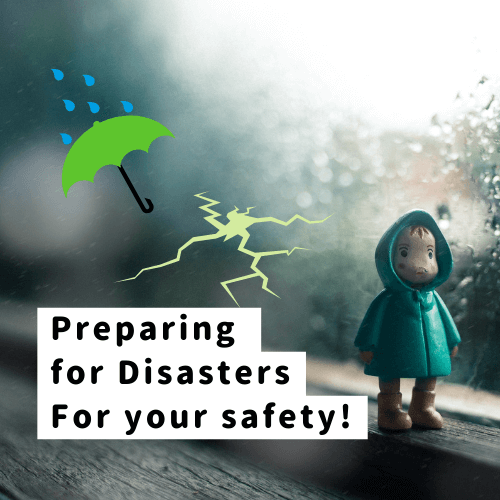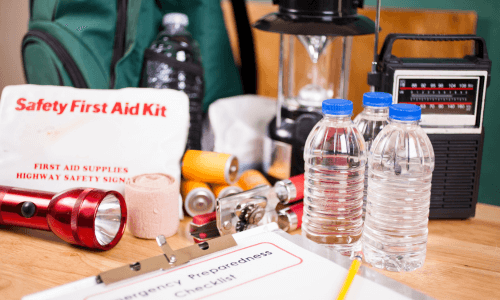4min read
1.Introduction
Hello APU students! Did you enjoy your summer break? Some of you may have had your plans disrupted by typhoons or heavy rainfall. I, too, had to change my travel plans hastily due to the effects of a typhoon, which was quite a challenge (laughs).
In recent years, unexpected disasters have been increasing worldwide. Japan, due to its geographical location, has faced various disasters over the years. Moreover, there is a very high probability that the "Nankai Trough Earthquake" will occur within the next 30 years. While we may not be at the epicenter of this anticipated quake, Beppu, where many of us live, is not exempt from its potential effects. However, there are ways to protect ourselves from such disasters. Let's deepen our knowledge of disaster preparedness and be ready for any emergencies!
2.What Kinds of Disasters Should We Be Aware Of?

Let's consider the city of Beppu, where we live. Beppu is a beautiful city with its proximity to the sea and mountains, but it also comes with its own set of risks. When you reside in APU Housing, you will participate in evacuation drills every semester. Be sure to join in.
First and foremost, earthquakes are a concern. In the event of a Nankai Trough Earthquake, Beppu is expected to experience strong shaking, ranging from seismic intensity 5 to 6. Seismic intensity 5 involves non-fixed furniture falling and block walls collapsing, while seismic intensity 6 makes standing difficult, and most furniture moves, and doors may become jammed. When an earthquake occurs, it's essential to be aware of the possibility of tsunamis. Especially, the APU Line of Oita Kotsu Bus runs along roads facing the sea, so extra caution is needed regarding tsunamis. In the event of a Nankai Trough Earthquake, a tsunami of approximately 2 to 5 meters is expected during high tide.
During heavy rainfall from typhoons or other sources, it's important to stay away from mountains and rivers. In case of disruptions to your commute due to typhoons or snow, your university classes may switch to online learning.
3.Preparations to Make in Advance
①Information
So, what should you do if a disaster occurs? The actions to take may vary depending on where you live, and they can also differ based on the type of disaster. For example, even designated evacuation areas may pose risks depending on the disaster. Beppu City provides hazard maps for such scenarios. By checking these hazard maps, you can find out where damage is expected and where you should evacuate. Interestingly, APU's gymnasium is also designated as an evacuation site! Make sure to check your residence, workplace, and frequently visited locations.
"Beppu City Hall Beppu City Disaster Prevention Map" - Disaster Words, Hazard Maps, Evacuation Centers, Disaster Preparedness Kits, etc.
Furthermore, during disasters, information can become extremely chaotic, and obtaining accurate information may be difficult. Those living alone should establish communication with nearby friends, while those living with family or roommates should confirm their designated meeting places. This way, you can ensure that you have a safe place to evacuate to and that your safety can be easily verified. However, if your designated evacuation site is deemed unsafe, you should move away from that location.

②Emergency Items to Take & Emergency Storage Item
Keep a disaster backpack with emergency supplies that you can take with you in the event of an evacuation.
The following text is taken from the Beppu City website.
Emergency Items to Take
Items to take when evacuating. Do not pack too much, and carry only what you really need.
Pack weight should be around 15 kg for men and 10 kg for women. Keep the items at the entrance, etc.
Emergency Storage Items
These are basic supplies for survival that you can stock in your home. When it is safe to return to your home after evacuation, you can go back and retrieve some of the items to take with you to your emergency shelter. Or, if you choose to stay and use your home as your emergency shelter, you can use them at home. Prepare items to last for at least three days to one week, if possible.
Please refer to the following list and prepare items for individual persons.
Item lists (Beppu City Disaster PreventionInformation)
https://www.city.beppu.oita.jp/doc/seikatu/gaikokujinmuke/ei/disaster/04.pdf
I think these items can be obtained at nearby supermarkets, 100-yen stores, and online shopping websites where you can purchase them in sets.
4.In Conclusion
Disasters often strike without warning, and we cannot predict their scale. To protect your life and the lives of others, take the time to confirm information and prepare necessary items. Also, when planning trips, make sure to thoroughly research the conditions of your destination!
<Other Useful Websites>
Many of these websites also offer English versions, so even if you are not proficient in Japanese, you can access information in English. Share these resources with your friends.
Emergency Disaster Response Handbook for APU students
Emergency Disaster Response Handbook
Disaster Management in Japan(Japan Cabinet Office)
Disseminating disaster information to foreign nationals (Explanation materials in 14 languages)
https://www.bousai.go.jp/kokusai/training.html
Manari Shimamura
Hello, I am Manari Shimamura (Graduated in March 2024). I love to travel and last year I visited 15 countries in Europe. This year, I will be traveling around Asia and Japan. APU and Beppu are full of interesting things to do! I will share with you the charms of APU and Beppu through articles!













